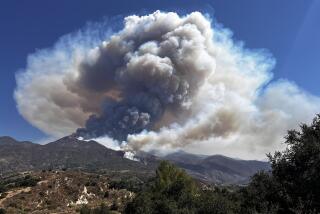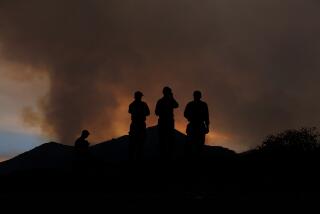Anxious Days in O.C.’s Tinderbox
- Share via
The wildfire that swept across parched San Diego County hills Wednesday rekindled painful images for Laguna Beach residents who lived through that city’s devastating 1993 blaze.
William Holden likened that disaster, when flames destroyed more than 300 homes, to battle scenes he saw during the Korean War. The sky turned black, he recalled, and explosions were everywhere.
During the Laguna fire, “even the house next door exploded,” said Holden, 70. Coast Highway through town became the exit route as people fled homes and businesses. Wednesday’s evacuation of San Diego County’s picturesque Alpine community brought back those memories.
The Canyon Acres Drive home that Holden and wife Melanie Ott had shared for 50 years was inexplicably spared. The fire seared their backyard but stopped just short of their house. That was close enough, though, to make the couple nervous whenever dry winds blow.
“It never left us. The fire colored our whole lives,” Melanie Ott said.
Across Orange County, people who live on the fringes of wilderness areas and in scenic canyon communities were reminded that danger is inherent in the sylvan life they have chosen.
“You know what I see when I looked up at these hills? I see fuel,” said wildlife artist Peter Paul Ott, 47, Melanie Ott’s brother.
In Silverado Canyon inside the Cleveland National Forest, a sign outside Orange County Fire Authority Station No. 15 on Wednesday read “Fire Danger Today: Extreme.”
“In the canyons, there’s usually only one way in and one way out,” said Julie Welch, a waitress at the Silverado Cafe. “People are careful how they put out cigarette butts around here.”
County fire officials have been on high alert occasionally since mid-December but continuously all this week.
During normal fire conditions in the county’s rural, brushy areas, officials dispatch one battalion chief, four fire engines and one water-dropping helicopter when any blaze is reported.
But during a high alert, the defensive force expands to two air-tanker planes, two water-dropping helicopters, two battalion chiefs, one division chief, two bulldozers, six fire engines, about 20 firefighters with shovels and chain saws, a paramedic, a pickup truck hauling 200 gallons of water and a larger truck carrying more than 1,000 gallons.
“We’re at the highest alert,” said Dennis Shell, a spokesman for the fire authority.
Though the strong winds that drove the Alpine blaze are expected to ease by this afternoon, gusts could continue into the weekend, said Alan Shoemaker, a meteorologist for Weather Central Inc., which forecasts weather for The Times.
When the wind blows hard, humidity in the canyons can drop as low as 5%, Shoemaker said. Because of that, most of Southern California is facing very high to extreme fire danger.
Silverado Canyon resident Jennifer Oto said she hopes the Native American lore that this idyllic area could never burn will prove true. She and husband Steve Oto are proprietors of Shadybrook Country Store and live in the same building, flanked by dry hillsides.
Some people believe the wind dances differently through here, she said, traveling in a kind of pirouette rather than sweeping down to the valley below. The week the Otos and their young daughter moved in, they spied a fire climbing a nearby ridge from Modjeska Canyon.
“It started coming up, then it seemed to back down,” she said. “I think the Indian story is true.”
More to Read
Sign up for Essential California
The most important California stories and recommendations in your inbox every morning.
You may occasionally receive promotional content from the Los Angeles Times.














